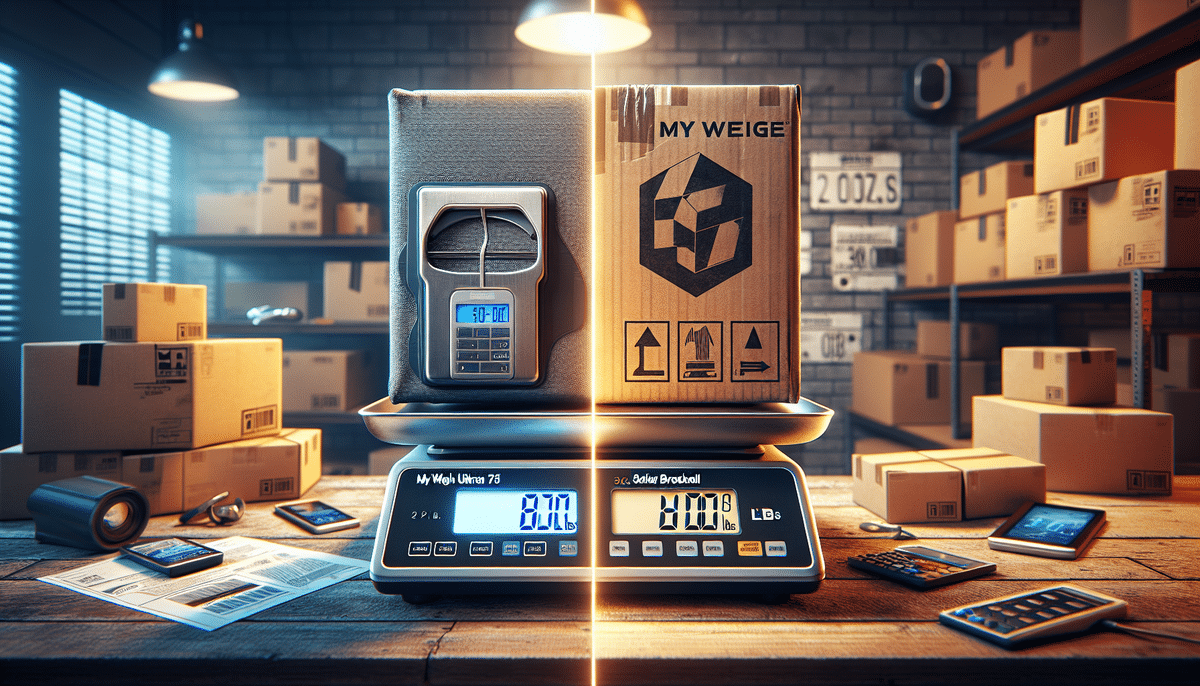Choosing the Best Digital Postal Scale: My Weigh Ultraship 75 vs Salter Brecknell LPS-400
Accurate package weighing is crucial for businesses that rely on mail services. Digital postal scales streamline the shipping process by providing precise weight measurements, calculating postage costs, and reducing the need for frequent trips to the post office. In this comprehensive comparison, we evaluate two leading models: the My Weigh Ultraship 75 and the Salter Brecknell LPS-400.
Understanding Digital Postal Scales
Digital postal scales are specialized tools designed to weigh packages and letters accurately to determine the appropriate postage. They typically display weight in units such as ounces, pounds, grams, or kilograms on an LCD screen. These scales enhance efficiency by calculating postage costs and often integrating with shipping software to print labels directly from a computer.
Key features often include a tare function, which allows users to weigh only the contents of a package by subtracting the container's weight, and data storage capabilities for tracking shipping costs across multiple orders. With varying sizes and weight capacities available, selecting the right scale is essential to meet specific business requirements.
Key Factors in Selecting a Digital Postal Scale
Weight Capacity and Precision
The weight capacity of a postal scale should align with your business's shipping needs. Scales with higher capacities are suitable for heavy-duty packages, while those with lower capacities are ideal for standard mail. Precision is equally important to ensure accurate postage calculations, which can impact both profitability and customer satisfaction.
Integration and Connectivity
Seamless integration with shipping software can significantly enhance workflow efficiency. Scales equipped with USB or RS-232 interfaces allow for easy connectivity with computers, printers, and barcode scanners, facilitating streamlined operations.
Durability and Design
A durable build ensures longevity, especially in high-usage environments. Additionally, the scale's design should complement your workspace and accommodate storage constraints.
Comparative Analysis: My Weigh Ultraship 75 vs Salter Brecknell LPS-400
My Weigh Ultraship 75
The My Weigh Ultraship 75 is a versatile digital postal scale capable of measuring up to 75 pounds. It offers multiple units of measurement, including ounces, grams, pounds, and kilograms, displayed on a large LCD screen. Key features include a tare function, hold feature to lock weight readings, and USB connectivity for integration with shipping software.
- Features:
- Switchable units of measurement for diverse shipping needs.
- Compact and durable design suitable for various business sizes.
- USB connectivity enables easy integration with multiple shipping platforms.
- Advantages:
- High precision at lower weights.
- User-friendly interface with a backlit display.
- Built-in postal rate chart for quick postage calculations.
- Disadvantages:
- Lower maximum weight capacity compared to LPS-400.
- Higher price point may be a consideration for budget-conscious businesses.
Salter Brecknell LPS-400
The Salter Brecknell LPS-400 is designed for businesses handling larger or heavier packages, offering a weight capacity of up to 400 pounds. It measures weight in pounds, ounces, and kilograms, featuring a large LCD screen, tare function, and USB port for connectivity. However, it requires proprietary software for integration, which may limit compatibility.
- Features:
- Built-in RS-232 interface for enhanced connectivity with printers and barcode scanners.
- Stainless steel platform ensures durability and ease of cleaning.
- High weight capacity caters to heavy-duty shipping requirements.
- Advantages:
- Robust construction suitable for high-volume and heavy packages.
- Consistent accuracy up to its maximum weight capacity.
- Disadvantages:
- Requires proprietary software, potentially limiting integration options.
- Less precise compared to Ultraship 75 at lower weights.
Design and Build Quality
Both the Ultraship 75 and the LPS-400 are constructed from high-quality materials, ensuring longevity and reliability. The Ultraship 75 boasts a sleek, modern design that fits well in various office settings, while the LPS-400 features a more traditional aesthetic with a stainless steel platform, ideal for heavy usage environments. The compact design of the Ultraship 75 makes it suitable for businesses with limited workspace, whereas the larger footprint of the LPS-400 may require more dedicated space.
Performance: Accuracy and Precision
Accuracy is paramount in digital postal scales to ensure correct postage calculations. The Ultraship 75 offers high precision, measuring weight in increments of 0.005 pounds, which is beneficial for businesses requiring exact measurements. Conversely, the LPS-400 measures in increments of 0.2 pounds, providing sufficient accuracy for general shipping needs but less precision for fine measurements.
Maximum weight capacity is another critical factor. The LPS-400 can handle up to 400 pounds, making it suitable for sizeable or heavy packages. In contrast, the Ultraship 75's 75-pound limit is ideal for standard mail and smaller parcels.
User Experience: Interface and Ease of Use
The Ultraship 75 is designed with user-friendliness in mind, featuring larger, well-spaced buttons and a backlit LCD display for clear visibility in various lighting conditions. These elements contribute to an intuitive and seamless user experience.
The LPS-400, while also user-friendly, has smaller, closely spaced buttons that may require a brief adjustment period for some users. Its interface is functional but less intuitive compared to the Ultraship 75.
In terms of connectivity, the Ultraship 75's USB interface is straightforward and compatible with a range of shipping software, offering greater flexibility. The LPS-400's reliance on proprietary software may limit integration options and complicate setup.
Durability and Maintenance
Both scales are built to withstand daily use in business environments. The Ultraship 75's compact and sturdy design ensures it remains operational over time, while the LPS-400's stainless steel platform offers enhanced durability, especially in high-traffic areas. Regular maintenance, such as cleaning the scale surface and ensuring proper connectivity, will extend the lifespan of either device.
Each model comes with a manufacturer's warranty, providing protection against defects and ensuring long-term reliability.
Cost Considerations
Pricing is a significant factor when selecting a digital postal scale. The Ultraship 75 is typically priced higher than the LPS-400, reflecting its advanced features such as higher precision, built-in postal rate charts, and more intuitive user interface. Businesses prioritizing accuracy and ease of use may find the Ultraship 75's cost justified.
On the other hand, the LPS-400 offers a higher weight capacity at a generally lower price point, making it a cost-effective solution for businesses that need to handle larger packages without the need for extreme precision.
Customer Feedback and Reviews
Customer reviews indicate strong satisfaction with both models, highlighting their respective strengths. Users of the Ultraship 75 commend its precision, user-friendly interface, and seamless software integration. The backlit display and tare function are frequently mentioned as valuable features.
Owners of the LPS-400 appreciate its robust construction and ability to handle heavy packages with ease. However, some users have noted challenges with the proprietary software, which can hinder integration with existing systems.
Overall, the Ultraship 75 tends to receive higher ratings for its versatility and ease of use, while the LPS-400 is favored for its durability and capacity.
Pros and Cons Summary
My Weigh Ultraship 75
- Pros:
- High precision measurements.
- USB connectivity for versatile software integration.
- Large, backlit LCD display enhances readability.
- Intuitive and user-friendly interface.
- Cons:
- Higher initial cost.
- Limited weight capacity for heavy packages.
Salter Brecknell LPS-400
- Pros:
- High weight capacity up to 400 pounds.
- Durable stainless steel construction.
- Suitable for heavy-duty shipping needs.
- Cons:
- Requires proprietary software for integration.
- Less precise at lower weight measurements.
Making the Right Choice for Your Business
Deciding between the My Weigh Ultraship 75 and the Salter Brecknell LPS-400 depends on your specific business needs. If your operations require precise weight measurements and seamless integration with various shipping software, the Ultraship 75 is the optimal choice. Conversely, if your business handles larger or heavier packages and prioritizes durability and weight capacity, the LPS-400 may better suit your requirements.
Conclusion
Both the My Weigh Ultraship 75 and Salter Brecknell LPS-400 are reliable digital postal scales that cater to different business needs. The Ultraship 75 excels in precision and user-friendly features, making it ideal for businesses that prioritize accuracy and software integration. The LPS-400 stands out with its high weight capacity and sturdy build, suitable for heavy-duty shipping operations. Assessing your business's specific requirements will guide you in selecting the scale that best enhances your shipping efficiency and operational effectiveness.




















